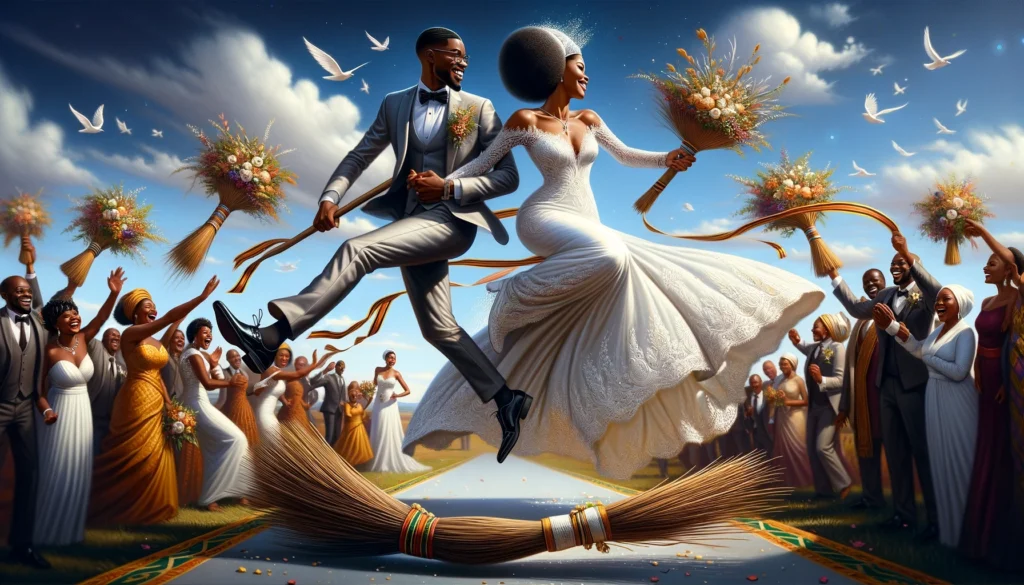Jumping the Broom: Everything You Need to About This Rich Tradition

“Where love meets heritage, and vows take flight.”
Jumping the broom—a phrase that evokes vibrant images of jubilant leaps, whispered vows, and the gentle sweep of straw against the earth. Yet, beneath its enchanting exterior lies a rich tapestry woven with history, resilience, and cultural celebration.
This cherished tradition is more than a whimsical act; it is a profound emblem in African American wedding ceremonies, steeped in a heritage that spans generations. Jumping the broom transcends the ordinary, symbolizing unity, love, and reverence for ancestry. It provides couples with a tangible connection to their roots, marking the beginning of their shared journey with a ritual that is both timeless and deeply meaningful.
Origins and Conflicting Accounts
The origins of jumping the broom are enshrouded in a tapestry of history and diverse narratives, each contributing to the multifaceted nature of this custom. The practice is believed to have roots in multiple cultures, each with its unique interpretation and significance.
In West Africa, brooms were traditionally employed to sweep away evil spirits. The act of jumping over a broom was thought to protect couples from malevolent forces, ensuring their union started on a solid foundation of safety and sanctity. This perspective places a spiritual emphasis on the tradition, linking it to a broader understanding of the world's unseen forces.
Conversely, in Wales, Roma people celebrated "Besom Weddings," which involved jumping over a broomstick. This act was a declaration of union in a community where formal marriages were often inaccessible, symbolising commitment and love in the face of societal challenges.
In the United States, during the era of slavery, enslaved couples found in broom jumping a way to marry, as legal marriage was denied to them. This act became a declaration of their union and love, a profound statement of resistance and humanity under inhumane conditions.
Symbolism and Meaning
The symbolism behind jumping the broom is rich and varied, encapsulating themes of new beginnings, unity, and cleansing. For many, it represents a fresh start for the couple, a leap into a new life together with optimism and joy. The act symbolises the sweeping away of old troubles, with the broom's bristles catching negative energy and past grievances, allowing the couple to enter their marriage with a clean slate.
Furthermore, the tradition serves as a bridge between families, honouring ancestors and uniting disparate lineages in a shared celebration. It is a physical manifestation of the couple's desire to honour their past while forging a new future together.
The cleansing aspect of the tradition is particularly poignant, symbolising the removal of negativity and the welcoming of positivity into the couple's life. It is an act of purification, preparing the space and the couple's future for happiness, prosperity, and love.
Modern-Day Practices
Today, jumping the broom remains a vibrant and meaningful tradition in many wedding ceremonies, adapted to fit the context of contemporary celebrations. Typically occurring after the exchange of vows, this ritual allows couples to physically and symbolically mark the beginning of their married life together.
The role of the officiant often includes providing context or an explanation of the tradition, enriching the ceremony with a sense of history and significance. The act of jumping is usually a joint effort, with the newlyweds leaping over the broom together in unison, symbolising their commitment to face life's challenges together.
Significantly, the choice of who places the broom on the ground can vary, often involving a significant person in the couple's life, further personalising the ceremony and embedding the tradition within the fabric of their relationships and community.
Cultural Resilience and Celebration

The enduring popularity of jumping the broom is a testament to the resilience of this tradition through the ages. Despite the challenges and changes over time, it remains a beloved practice, celebrated for its ability to connect the present with the past and to honour the enduring strength of love and community.
This tradition serves as a vibrant celebration of cultural heritage, a reminder of the power of rituals to convey meaning, unite people, and celebrate the foundational values of love, unity, and resilience.
Conclusion
Jumping the broom is a tradition rich in history, meaning, and emotion. It stands as a testament to the enduring importance of cultural practices in celebrating love, honouring ancestors, and bringing families together. As we witness or participate in this tradition, it's crucial to appreciate the depth of its roots and the breadth of its significance.
This simple act is a powerful symbol of life's new beginnings, the strength of unity, and the cleansing of past hurdles, embodying the hope and joy that marriage promises.
Let us cherish and continue to share the rich cultural tapestry that jumping the broom represents, celebrating its timeless relevance in weddings and the union of hearts.


